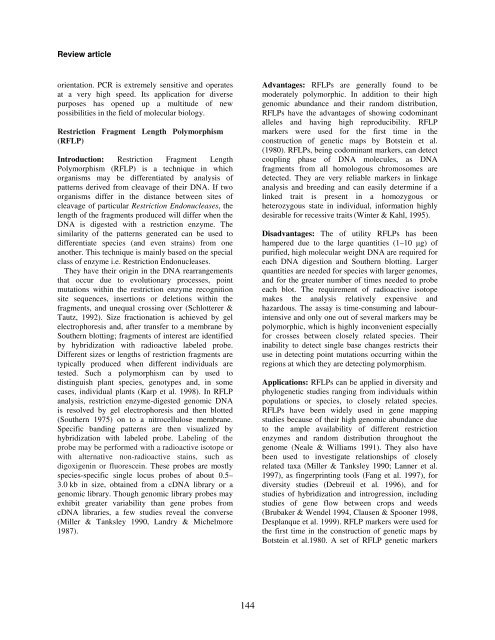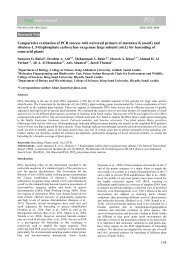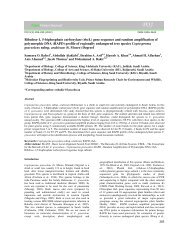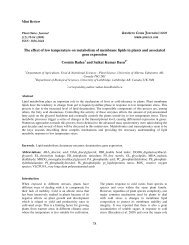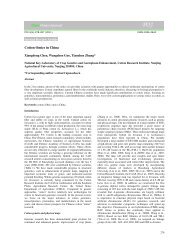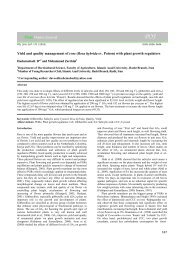Potential of Molecular Markers in Plant Biotechnology - ResearchGate
Potential of Molecular Markers in Plant Biotechnology - ResearchGate
Potential of Molecular Markers in Plant Biotechnology - ResearchGate
You also want an ePaper? Increase the reach of your titles
YUMPU automatically turns print PDFs into web optimized ePapers that Google loves.
Review article<br />
orientation. PCR is extremely sensitive and operates<br />
at a very high speed. Its application for diverse<br />
purposes has opened up a multitude <strong>of</strong> new<br />
possibilities <strong>in</strong> the field <strong>of</strong> molecular biology.<br />
Restriction Fragment Length Polymorphism<br />
(RFLP)<br />
Introduction: Restriction Fragment Length<br />
Polymorphism (RFLP) is a technique <strong>in</strong> which<br />
organisms may be differentiated by analysis <strong>of</strong><br />
patterns derived from cleavage <strong>of</strong> their DNA. If two<br />
organisms differ <strong>in</strong> the distance between sites <strong>of</strong><br />
cleavage <strong>of</strong> particular Restriction Endonucleases, the<br />
length <strong>of</strong> the fragments produced will differ when the<br />
DNA is digested with a restriction enzyme. The<br />
similarity <strong>of</strong> the patterns generated can be used to<br />
differentiate species (and even stra<strong>in</strong>s) from one<br />
another. This technique is ma<strong>in</strong>ly based on the special<br />
class <strong>of</strong> enzyme i.e. Restriction Endonucleases.<br />
They have their orig<strong>in</strong> <strong>in</strong> the DNA rearrangements<br />
that occur due to evolutionary processes, po<strong>in</strong>t<br />
mutations with<strong>in</strong> the restriction enzyme recognition<br />
site sequences, <strong>in</strong>sertions or deletions with<strong>in</strong> the<br />
fragments, and unequal cross<strong>in</strong>g over (Schlotterer &<br />
Tautz, 1992). Size fractionation is achieved by gel<br />
electrophoresis and, after transfer to a membrane by<br />
Southern blott<strong>in</strong>g; fragments <strong>of</strong> <strong>in</strong>terest are identified<br />
by hybridization with radioactive labeled probe.<br />
Different sizes or lengths <strong>of</strong> restriction fragments are<br />
typically produced when different <strong>in</strong>dividuals are<br />
tested. Such a polymorphism can by used to<br />
dist<strong>in</strong>guish plant species, genotypes and, <strong>in</strong> some<br />
cases, <strong>in</strong>dividual plants (Karp et al. 1998). In RFLP<br />
analysis, restriction enzyme-digested genomic DNA<br />
is resolved by gel electrophoresis and then blotted<br />
(Southern 1975) on to a nitrocellulose membrane.<br />
Specific band<strong>in</strong>g patterns are then visualized by<br />
hybridization with labeled probe. Label<strong>in</strong>g <strong>of</strong> the<br />
probe may be performed with a radioactive isotope or<br />
with alternative non-radioactive sta<strong>in</strong>s, such as<br />
digoxigen<strong>in</strong> or fluoresce<strong>in</strong>. These probes are mostly<br />
species-specific s<strong>in</strong>gle locus probes <strong>of</strong> about 0.5–<br />
3.0 kb <strong>in</strong> size, obta<strong>in</strong>ed from a cDNA library or a<br />
genomic library. Though genomic library probes may<br />
exhibit greater variability than gene probes from<br />
cDNA libraries, a few studies reveal the converse<br />
(Miller & Tanksley 1990, Landry & Michelmore<br />
1987).<br />
Advantages: RFLPs are generally found to be<br />
moderately polymorphic. In addition to their high<br />
genomic abundance and their random distribution,<br />
RFLPs have the advantages <strong>of</strong> show<strong>in</strong>g codom<strong>in</strong>ant<br />
alleles and hav<strong>in</strong>g high reproducibility. RFLP<br />
markers were used for the first time <strong>in</strong> the<br />
construction <strong>of</strong> genetic maps by Botste<strong>in</strong> et al.<br />
(1980). RFLPs, be<strong>in</strong>g codom<strong>in</strong>ant markers, can detect<br />
coupl<strong>in</strong>g phase <strong>of</strong> DNA molecules, as DNA<br />
fragments from all homologous chromosomes are<br />
detected. They are very reliable markers <strong>in</strong> l<strong>in</strong>kage<br />
analysis and breed<strong>in</strong>g and can easily determ<strong>in</strong>e if a<br />
l<strong>in</strong>ked trait is present <strong>in</strong> a homozygous or<br />
heterozygous state <strong>in</strong> <strong>in</strong>dividual, <strong>in</strong>formation highly<br />
desirable for recessive traits (W<strong>in</strong>ter & Kahl, 1995).<br />
Disadvantages: The <strong>of</strong> utility RFLPs has been<br />
hampered due to the large quantities (1–10 µg) <strong>of</strong><br />
purified, high molecular weight DNA are required for<br />
each DNA digestion and Southern blott<strong>in</strong>g. Larger<br />
quantities are needed for species with larger genomes,<br />
and for the greater number <strong>of</strong> times needed to probe<br />
each blot. The requirement <strong>of</strong> radioactive isotope<br />
makes the analysis relatively expensive and<br />
hazardous. The assay is time-consum<strong>in</strong>g and labour<strong>in</strong>tensive<br />
and only one out <strong>of</strong> several markers may be<br />
polymorphic, which is highly <strong>in</strong>convenient especially<br />
for crosses between closely related species. Their<br />
<strong>in</strong>ability to detect s<strong>in</strong>gle base changes restricts their<br />
use <strong>in</strong> detect<strong>in</strong>g po<strong>in</strong>t mutations occurr<strong>in</strong>g with<strong>in</strong> the<br />
regions at which they are detect<strong>in</strong>g polymorphism.<br />
Applications: RFLPs can be applied <strong>in</strong> diversity and<br />
phylogenetic studies rang<strong>in</strong>g from <strong>in</strong>dividuals with<strong>in</strong><br />
populations or species, to closely related species.<br />
RFLPs have been widely used <strong>in</strong> gene mapp<strong>in</strong>g<br />
studies because <strong>of</strong> their high genomic abundance due<br />
to the ample availability <strong>of</strong> different restriction<br />
enzymes and random distribution throughout the<br />
genome (Neale & Williams 1991). They also have<br />
been used to <strong>in</strong>vestigate relationships <strong>of</strong> closely<br />
related taxa (Miller & Tanksley 1990; Lanner et al.<br />
1997), as f<strong>in</strong>gerpr<strong>in</strong>t<strong>in</strong>g tools (Fang et al. 1997), for<br />
diversity studies (Debreuil et al. 1996), and for<br />
studies <strong>of</strong> hybridization and <strong>in</strong>trogression, <strong>in</strong>clud<strong>in</strong>g<br />
studies <strong>of</strong> gene flow between crops and weeds<br />
(Brubaker & Wendel 1994, Clausen & Spooner 1998,<br />
Desplanque et al. 1999). RFLP markers were used for<br />
the first time <strong>in</strong> the construction <strong>of</strong> genetic maps by<br />
Botste<strong>in</strong> et al.1980. A set <strong>of</strong> RFLP genetic markers<br />
144


